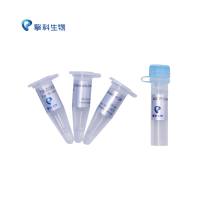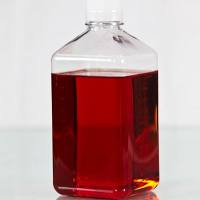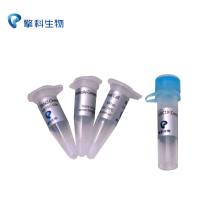CCMB buffer to make chemical competent cell
丁香园论坛
2840
TOP10 chemically competent cells
( modified from http://openwetware.org/wiki/TOP10_chemically_competent_cells#CCMB80_buffer)
I also use this protocol to make Ecoli compent cell. It is pretty good.
You can start from the fresh clone on plate, but you need a big clone or several clones. :D
LB media is OK,
OD less than 0.8 is OK
This protocol has been tested on TOP10, MachI and BL21(DE3) , DH5α cells.
1 Preparing glassware and media
2 Preparing seed stocks
3 Preparing competent cells
4 CCMB80 buffer
5 Measurement of competence
6 5x Ligation Adjustment Buffer
7 References
1.Preparing glassware and media
Detergent is a major inhibitor of competent cell growth and transformation. Glass and plastic must be detergent free for these protocols. The easiest way to do this is to avoid washing glassware, and simply rinse it out. Autoclaving glassware filled 3/4 with DI water is an effective way to remove most detergent residue. Media and buffers should be prepared in detergent free glassware and cultures grown up in detergent free glassware.
2. Preparing seed stocks
streak TOP10 cells on an SOB plate and grow for single colonies at 23 C
room temperature works well
Pick single colonies into 2 ml of SOB medium and shake overnight at 23 C
room temperature works well
Add glycerol to 15%
Aliquot 1 ml samples to Nunc cryotubes
Place tubes into a zip lock bag, immerse bag into a dry ice/ethanol bath for 5 minutes
This step may not be necessary
Place in -80 freezer indefinitely.
3. Preparing competent cells
Inoculate 250 ml of SOB medium with 1 ml vial of seed stock and grow at 20 C to an OD of 0.3
This takes approximately 16 hours.
Controlling the temperature makes this a more reproducible process, but is not essential.
Room temperature will work. You can adjust this temperature somewhat to fit your schedule
Aim for lower, not higher OD if you can't hit this mark
Centrifuge at 3000g / 4C for 10 minutes in a flat bottom centrifuge bottle.
Flat bottom centrifuge tubes make the fragile cells much easier to resuspend
It is often easier to resuspend pellets by mixing before adding large amounts of buffer
Gently resuspend in 80 ml of ice cold CCMB80 buffer
sometimes this is less than completely gentle. It still works.
Incubate on ice 20 minutes
Centrifuge again at 4C and resuspend in 20 ml of ice cold CCMB80 buffer.
Incubate on ice for 20 minutes
Aliquot to chilled screw top 2 ml vials or 50 μl into chilled microtiter plates
Store at -80C indefinitely.
Flash freezing does not appear to be necessary
Test competence (see below)
Good cells should yield around 100 - 400 colonies
4. CCMB80 buffer
10 mM KOAc pH 7.0 (10 ml of a 1M stock/l)
80 mM CaCl2.2H2O (11.8 g/l)
20 mM MnCl2.4H2O (4.0 g/l)
10 mM MgCl2.6H2O (2.0 g/l)
10% glycerol (100 ml/l)
adjust pH DOWN to 6.4 with 0.1N HCl if necessary
adjusting pH up will precipitate manganese dioxide from Mn containing solutions.
sterile filter and store at 4C
slight dark precipitate appears not to affect its function
5. Measurement of competence
Transform 50 μl of cells with 1 μl of standard pUC19 plasmid (Invitrogen)
This is at 10 pg/μl or 10-5 μg
Hold on ice 0.5 hours
Heat shock 60 sec at 42C
Add 250 μl SOC
Incubate at 37 C for 1 hour in 2 ml centrifuge tubes rotated
using 2ml centrifuge tubes for transformation and regrowth works well because the small volumes flow well when rotated, increasing aeration.
chloramphenicol and tetracycline resistant, growing for 2 hours yields many more colonies
Ampicillin and kanamycin appear to do fine with 1 hour growth
Plate 20 μl on AMP plates using 3.5 mm glass beads
Transformation efficiency is 15 x colony count x 105
There is anecdotal evidence that refreezing partially used cell aliquots dramatically reduces transformation efficiency.
6. 5x Ligation Adjustment Buffer
Intended to be mixed with ligation reactions to adjust buffer composition to be near the CCMB80 buffer
KOAc 40 mM (40 ml/liter of 1 M KOAc solution, pH 7.0)
CaCl2 400 mM (200 ml/l of a 2 M solution)
MnCl2 100 mM (100 ml/l of a 1 M solution)
Glycerol 46.8% (468 ml/liter)
pH adjustment with 2.3% of a 10% acetic acid solution (12.8ml/liter)
Previous protocol indicated amount of acetic acid added should be 23 ml/liter but that amount was found to be 2X too much per tests on 1.23.07 --Meaganl 15:50, 25 January 2007 (EST)
water to 1 liter
autoclave or sterile filter
Test pH adjustment by mixing 4 parts ligation buffer + 1 part 5x ligation adjustment buffer and checking pH to be 6.3 - 6.5
( modified from http://openwetware.org/wiki/TOP10_chemically_competent_cells#CCMB80_buffer)
I also use this protocol to make Ecoli compent cell. It is pretty good.
You can start from the fresh clone on plate, but you need a big clone or several clones. :D
LB media is OK,
OD less than 0.8 is OK
This protocol has been tested on TOP10, MachI and BL21(DE3) , DH5α cells.
1 Preparing glassware and media
2 Preparing seed stocks
3 Preparing competent cells
4 CCMB80 buffer
5 Measurement of competence
6 5x Ligation Adjustment Buffer
7 References
1.Preparing glassware and media
Detergent is a major inhibitor of competent cell growth and transformation. Glass and plastic must be detergent free for these protocols. The easiest way to do this is to avoid washing glassware, and simply rinse it out. Autoclaving glassware filled 3/4 with DI water is an effective way to remove most detergent residue. Media and buffers should be prepared in detergent free glassware and cultures grown up in detergent free glassware.
2. Preparing seed stocks
streak TOP10 cells on an SOB plate and grow for single colonies at 23 C
room temperature works well
Pick single colonies into 2 ml of SOB medium and shake overnight at 23 C
room temperature works well
Add glycerol to 15%
Aliquot 1 ml samples to Nunc cryotubes
Place tubes into a zip lock bag, immerse bag into a dry ice/ethanol bath for 5 minutes
This step may not be necessary
Place in -80 freezer indefinitely.
3. Preparing competent cells
Inoculate 250 ml of SOB medium with 1 ml vial of seed stock and grow at 20 C to an OD of 0.3
This takes approximately 16 hours.
Controlling the temperature makes this a more reproducible process, but is not essential.
Room temperature will work. You can adjust this temperature somewhat to fit your schedule
Aim for lower, not higher OD if you can't hit this mark
Centrifuge at 3000g / 4C for 10 minutes in a flat bottom centrifuge bottle.
Flat bottom centrifuge tubes make the fragile cells much easier to resuspend
It is often easier to resuspend pellets by mixing before adding large amounts of buffer
Gently resuspend in 80 ml of ice cold CCMB80 buffer
sometimes this is less than completely gentle. It still works.
Incubate on ice 20 minutes
Centrifuge again at 4C and resuspend in 20 ml of ice cold CCMB80 buffer.
Incubate on ice for 20 minutes
Aliquot to chilled screw top 2 ml vials or 50 μl into chilled microtiter plates
Store at -80C indefinitely.
Flash freezing does not appear to be necessary
Test competence (see below)
Good cells should yield around 100 - 400 colonies
4. CCMB80 buffer
10 mM KOAc pH 7.0 (10 ml of a 1M stock/l)
80 mM CaCl2.2H2O (11.8 g/l)
20 mM MnCl2.4H2O (4.0 g/l)
10 mM MgCl2.6H2O (2.0 g/l)
10% glycerol (100 ml/l)
adjust pH DOWN to 6.4 with 0.1N HCl if necessary
adjusting pH up will precipitate manganese dioxide from Mn containing solutions.
sterile filter and store at 4C
slight dark precipitate appears not to affect its function
5. Measurement of competence
Transform 50 μl of cells with 1 μl of standard pUC19 plasmid (Invitrogen)
This is at 10 pg/μl or 10-5 μg
Hold on ice 0.5 hours
Heat shock 60 sec at 42C
Add 250 μl SOC
Incubate at 37 C for 1 hour in 2 ml centrifuge tubes rotated
using 2ml centrifuge tubes for transformation and regrowth works well because the small volumes flow well when rotated, increasing aeration.
chloramphenicol and tetracycline resistant, growing for 2 hours yields many more colonies
Ampicillin and kanamycin appear to do fine with 1 hour growth
Plate 20 μl on AMP plates using 3.5 mm glass beads
Transformation efficiency is 15 x colony count x 105
There is anecdotal evidence that refreezing partially used cell aliquots dramatically reduces transformation efficiency.
6. 5x Ligation Adjustment Buffer
Intended to be mixed with ligation reactions to adjust buffer composition to be near the CCMB80 buffer
KOAc 40 mM (40 ml/liter of 1 M KOAc solution, pH 7.0)
CaCl2 400 mM (200 ml/l of a 2 M solution)
MnCl2 100 mM (100 ml/l of a 1 M solution)
Glycerol 46.8% (468 ml/liter)
pH adjustment with 2.3% of a 10% acetic acid solution (12.8ml/liter)
Previous protocol indicated amount of acetic acid added should be 23 ml/liter but that amount was found to be 2X too much per tests on 1.23.07 --Meaganl 15:50, 25 January 2007 (EST)
water to 1 liter
autoclave or sterile filter
Test pH adjustment by mixing 4 parts ligation buffer + 1 part 5x ligation adjustment buffer and checking pH to be 6.3 - 6.5









